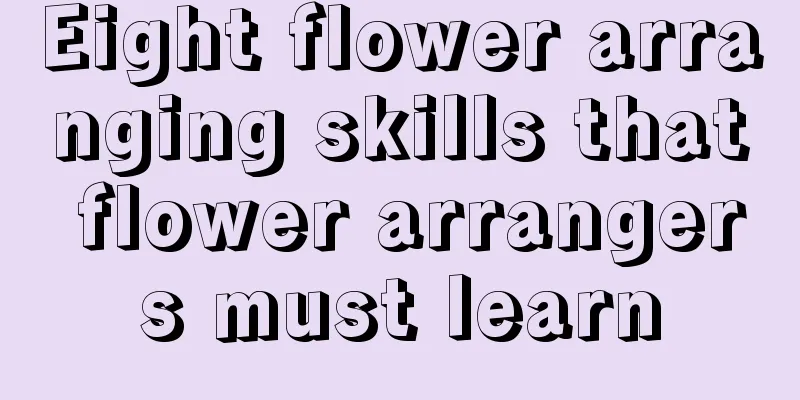Eight flower arranging skills that flower arrangers must learn

Flower ArrangementIn short, flower arrangement refers to using cut plant branches, leaves, flowers and fruits as materials, and through certain technical (pruning, pruning, bending, etc.) and artistic (conceptualization, modeling and coloring, etc.) processing, re-arrange them into a delicate, beautiful, poetic and picturesque floral art that can reproduce the beauty of nature and life. Therefore, it is called flower arrangement art. Flower arranging seems simple and easy, but it is not easy to really make a good work. Because it is neither a simple combination of various flowers nor a simple shape, but an artistic creation activity that requires conveying the spirit through form, having both form and spirit, moving people with emotion, and integrating life, knowledge, and art. Friends in the flower arrangement circle at home and abroad believe that flower arrangement is a plastic art that uses flower shapes to create flower shapes with heart and expresses one's mentality. Eight flower arranging skills that flower arrangers must learnLight on top and heavy on bottom: the buds are on top, the full flowers are on the bottom; the light colors are on top, the dark colors are on the bottom, in an orderly sequence and completely natural. Scattered above and gathered below: flowers, branches and leaves are lush at the bottom and have strong roots; the upper part is sparse and has various shapes and forms. Staggered height: The positions of the flowers should be staggered front to back, and should never be placed on the same horizontal or straight line. Well-balanced density: Flowers and leaves should not be arranged at equal distances, but should be arranged in a sparse and dense manner to create a sense of rhythm. Echoes of ups and downs: To establish the center, the surrounding flowers and branches should echo each other around the center, which not only highlights the theme but also has a sense of balance. Combination of the real and the virtual: flowers are real and leaves are virtual. Flowers without leaves lack contrast, and leaves without flowers lack substance. This is what is meant by "Red flowers still need green leaves to support them." The combination of movement and stillness: there should be both static symmetry and dynamic irregularity. Both solemn and humorous: it must have the classical elegance and balance, and at the same time create a unique artistic conception through changes in material selection and composition. |
<<: The flower language and symbolic meaning of the beauty cherry
>>: Taboos on the placement of lucky bamboo
Recommend
How long is the growth cycle of Oyster mushrooms?
Introduction to the growth of Oyster Mushroom Oys...
How to plant garlic
Garlic has a unique flavor and is grown throughou...
How to grow spider plants and what should you pay attention to?
Chlorophytum is widely loved for its evergreen na...
Monk fruit planting conditions and methods
Luo Han Guo , a perennial climbing plant belongin...
How to raise a lucky tree at home
Can the lucky tree be cultivated at home? The luc...
How to water roses? The correct watering method
Overview of Watering Roses When watering roses, i...
Old succulent plants are too expensive! In just 4 steps, the seedling can be turned into an old tree immediately, without spending a penny!
Change to a larger pot to give the succulents eno...
In winter, you can grow these large potted plants that cannot be killed by freezing. They are evergreen and cold-resistant all year round!
1. Winter Heather It is an evergreen shrub, very ...
Flower language of the cardinal lantern
1. Lotus Lantern There are about 300 varieties of...
Four seasons maintenance methods of Anthurium
1. Spring maintenance It likes diffuse light, and...
How often should Schefflera be watered? How often should it be watered?
How often should I water Schefflera During the ma...
The thumb-sized "radish" with branches and leaves on top can be used for stir-frying, and the whole family’s dining table will be filled with delicious aroma!
There are all kinds of vegetables sold in the mar...
Cultivation methods and precautions of calla lily
Calla lily is very easy to grow. It is a green pl...
Can winter wheat be sown in spring (when to sow winter wheat and spring wheat)
China has a vast territory and many places for gr...
How to Propagate Clivia
1. Seed Harvesting First, seeds must be collected...









